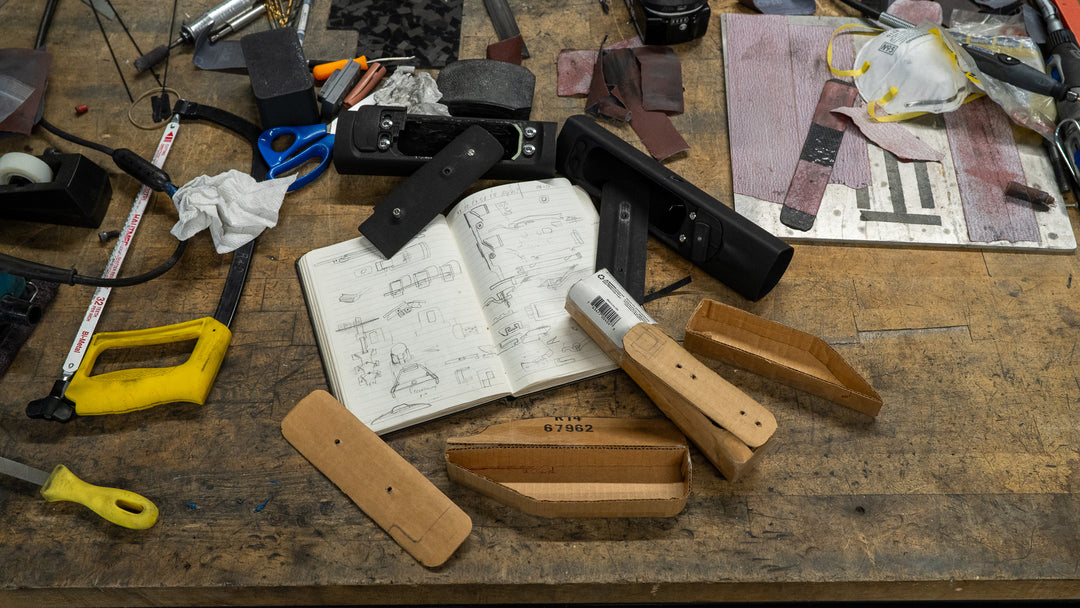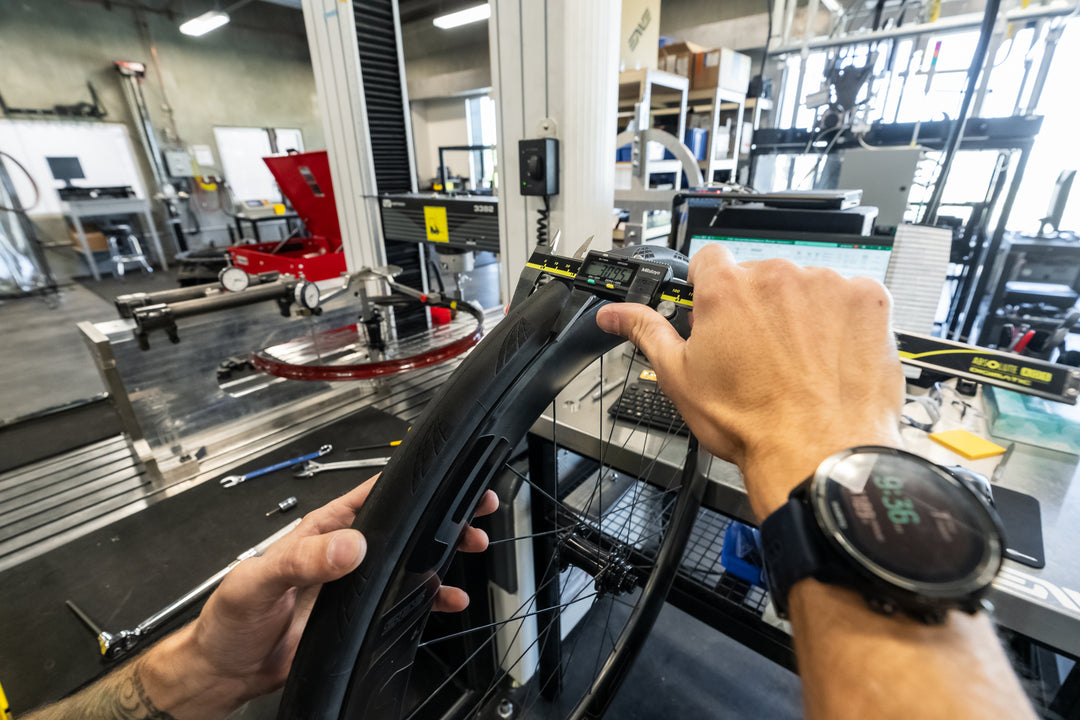Builder Profile: FiftyOne Bikes
In the first of a new series taking an in-depth look at the incredibly talented and diverse builders with whom ENVE works, we meet FiftyOne Bikes, from Dublin, Ireland, to learn about old influences, chance meetings, and an ingenious paint scheme creation method.
FiftyOne understands something known by few other builders – in most cases, you don’t begin the process of building someone’s dream bike by handing them a blank sheet; you can’t learn what they want simply by asking them. You have to probe, delve, investigate. You have to get them.
This ethos is at the very core of what FiftyOne is about and it grew from a seed planted decades ago, when founder Aidan Duff was racing at home in Ireland and then in Europe, professionally, for such teams as Vendée U.
“That was 20 years ago,” he tells us, “before carbon monocoques took over, so all of the frames I’ve had since I was a junior have been hand built to my dimensions, and I could build the characteristics that I wanted into them. When I started to compare the experience and the finished product that I had back then to what is available now, and particularly the prices people are willing to pay for a stock Chinese-made frame, I thought, ‘There’s something wrong here that people are spending 10, 12 even €15k on a bike, without having any input on how it should look or handle or fit.’




“THE BIG BRANDS HAVE LEFT THE DOOR WIDE OPEN FOR CUSTOM BUILDERS BECAUSE THE HALO MODELS ARE NOW SO EXPENSIVE. I THINK THAT’S QUITE EXCITING”
“All the big manufacturers take a safe option with geometry, which is normal because they’re making bikes for a global market, but it meant that no matter what I was willing to spend, I couldn’t find a bike that handled the way I wanted it to. It started driving me crazy because when you’re descending at high speed, it’s the difference between real confidence and feeling like you’re second guessing the bike. The big brands have left the door wide open for custom builders because the halo models are now so expensive. I think that’s quite exciting.
“I knew I wanted to deliver a more holistic approach to bike building and the customer experience, and that’s what took longer, figuring out how to do it, given the skill sets that I had and the people I had in my team. I have 20 years of experience in the bike industry but that’s primarily in retail and distribution. So, the sales and marketing side
Usually at this point, the sales and marketing type takes a trip to China, visits a few factories, picks out a decent enough open mold frame, and then goes home to design the decals and headtube badge that will do the heavy lifting for brand building in place of any engineering mission. Of course, that’s anathema to Aidan, and his formative experiences as a junior racer. Instead, here began a quest for a builder able to do the job right.
“I knew we had to be in a position to offer bespoke sizing, so that took all Far Eastern manufacturing off the table. We looked around Europe, particularly in Italy, where there are quite a few workshops offering that type of service, but when we saw the level of workmanship and the amount of time that was taken, or not taken, we were rather underwhelmed. We had images of one man building a bike from start to finish, you know, and putting a little piece of his soul into every creation. The reality, of course, is that these little workshops are trying to be businesses, so they’re pumping out seven or eight frames per day. The time they were taking over each unit wasn’t enough, and I didn’t think the results were good enough.
“I wasn’t willing to compromise, so we were in a corner: we didn’t want to do it in Asia and we didn’t want to do it in Europe, which meant we were going to have do it ourselves.”










“I LOVE THAT WE HAVE THIS REAL OLD SCHOOL MACHINERY AND WE’RE USING IT TO MAKE VERY MODERN FRAMES”
It’s one thing to out-source frame building to your spec, another altogether to set yourself up as a manufacturer. Undeterred, Aidan went about learning what he needed and where to get it. That search took him to Bavaria, in Germany, where he found, among other things, his crunch point.
“After a lot of searching, I’d found out about Mauro Sannino, a master builder of steel frames who had transferred his talents to carbon. We went to visit him in southern Germany to learn more, witness the production, and get a better understanding of what machinery we would require. It wasn’t until the night before we were due to travel that we heard Mauro had retired and not built a frame in over a year. I nearly cancelled the trip but then thought we could still learn something. When they pulled back the shutters, it was quite a sad sight to see all this machinery, some of it under wraps, some of it not, just sat there, slowly dying. I looked at them and they looked at me and it was one of those moments, you know? I knew what I wanted to do and what that needed, and here was this factory facing me, so it was ‘sh*t or get off the pot’. Once the factory was packed up into three 40ft trucks and heading to Ireland, there was no going back. We had to make it work.”
In conversation with Aidan, it’s clear that he’s objective about what he can and cannot do himself, and that he’s good at finding the talented people he needs. Frame builder Aaron Marsit brought extensive experience in making steel frames; friends around the industry, including at ENVE, gave support, too. At first, they spent time learning the machinery, making some frame sections, then complete frames for testing. “It’s easy in hindsight to say the learning curve wasn’t too bad but each step is a new step and you’re breaking ice every moment. I love that we have this real old school machinery and we’re using it to make very modern frames.”
Given how profoundly Aidan’s early experiences as a bespoke frame customer have influenced his ideas for FiftyOne, we wonder whether his own preferences for handling might now influence the bikes his company is building. We put it to him.
“Good question. I’ve always preferred a steeper headtube. Back then, a 74˚ or 74.5˚ headtube was typical. I like my bikes to corner like they’re on rails. I try not to push that on customers but often they hear how passionate I am about that particular aspect and it has influenced some customer builds.”







“THAT WAS A BIG LEARNING CURVE FOR US, SO THE DAYS OF THE BLANK CANVAS ARE GONE”
One of the most interesting things about FiftyOne is the system it has established to assist customers with developing ideas of how they want their bike to look. Laymen so often say, “I don’t know much about (art, wine, bicycle paint schemes…) but I know what I like.” Coming up with something individual and also original requires both a means of articulating those preferences beyond examples and creativity. If you’re not artistically creative, a white page can be intimidating.
“It’s something we had to learn along the way,” says Aidan, “because when we started we thought ‘This is great, we can do anything.’ But when you slide a blank canvas in front of people they just clog up.
“One of the very first frames we did, we thought we had everything dialed in, and we said to the guy, ‘So, what paintjob do you want?’ and he couldn’t tell us. In the end he said, ‘I’ve got a McLaren Venge, just do the same as that but with the orange bit in green’, and it was the most underwhelming moment. I realized we had to do something about it, so we went back to him and started to peel away all the layers. He’s a car nut and his passion is Porsche. We thought that was something we could build on. We eventually teased out of him that his dream car was this Rothmans Porsche 956 Le Mans racer and that ended up being the inspiration for the bike. We took it to the Bespoked show in the UK and it won the Campagnolo Choice award. That was a big learning curve for us, so the days of the blank canvas are gone.”
In order to consistently cut through to each customer’s real aesthetic loves, FiftyOne began using two new tools, which are as different from each other as they are from the decades old frame building machinery: a psychometric test and Pinterest. In very different ways, each gets past any difficulty the customer might have in expressing what they like. It’s genius.
“The psychometric test accelerates the rapport between us and gives us a much better idea about them. We work a lot with Pinterest, as well. If I ask the client what they like, they might have trouble articulating all of it, but using Pinterest we can see patterns. Maybe they like contrast, or certain base colours. It’s another tool to make the relationship between us and the client richer.
“The best thing I can compare it to is if you were to build your own house, you’d employ an architect. You’d never be left on your own with it for a moment, but when it comes to turning the key in the door for the first time there’s no doubt that it’s your house, no risk that you won’t be happy with it, because you’ve validated every step along the way.”
This upstart brand isn’t about building the bike their designer would like you to have, and nor is it satisfied with building the bike you think you want; it’s committed to building the even more special bike that you didn’t even know you wanted. No wonder it’s taking off so fast.
FiftyOne is at the forefront of what might become a new wave in frame building, where custom is no longer enough. This time, it’s personal.




